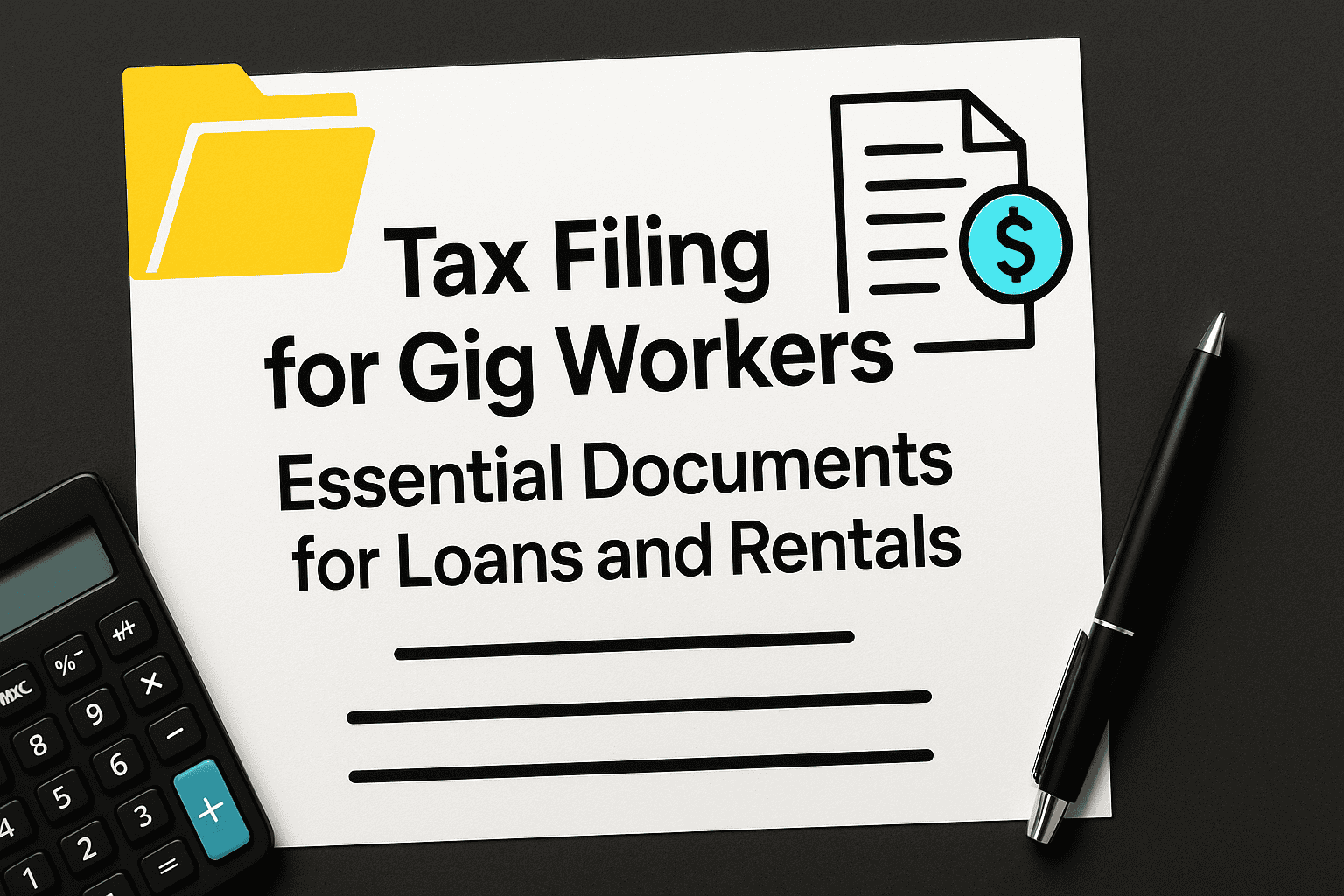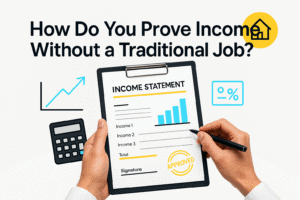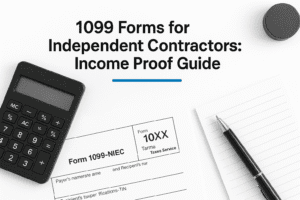Introduction
Published: August 22, 2025 • By FinancialDocsProvider Editorial Team
Last updated: August 2025

If you’re navigating tax filing for gig workers and need documents for a rental, auto loan, SBA application, or mortgage pre‑approval, you’re in the right place. Landlords and lenders usually want tax‑anchored evidence plus recent bank activity to confirm your earnings and capacity to pay. Our role is simple and compliance‑first: we edit, format, organize, and lawfully redact your existing documents so they’re clear and reviewer‑ready—never fabricated.
Below you’ll find exactly what to collect in the US, UK, and Canada, how to package it, and what edits are acceptable. We also include mini‑scenarios and checklists you can follow immediately. If you’d like hands‑on help with proof of income editing and bank statement formatting, our team can prepare a clean, consistent packet that matches the request.
Related Entities & Terms
- W‑2 (US employees), 1099‑NEC/1099‑MISC (US contractors), 1099‑K (platform payouts)
- Form 1040 + Schedule C (sole proprietors), IRS tax transcripts (Return; Wage & Income)
- HMRC Self Assessment, SA302 tax calculation & Tax Year Overview (UK)
- P60/P45 (UK employment), UTR (Unique Taxpayer Reference)
- CRA Notice of Assessment (NOA), Proof of Income Statement (“Option C”), T2125
- T4/T4A (Canada slips), FCAC (Canada), CRA (Canada), HMRC (UK)
- CFPB, FTC, IRS (US regulators)
- FCA (UK regulator), GOV.UK guidance
- Bank statements, platform payout reports (Uber, Lyft, DoorDash, Upwork, Fiverr, Shopify)
- Underwriting checklists, income‑to‑rent ratio, debt‑to‑income (DTI)
- OCR, PDF packaging, privacy‑safe redaction
- Mortgage pre‑approval, dealer financing, SBA loans
Want a deeper dive on assembling freelancer/gig‑worker proof of income? See our companion guide: proof of income for freelancers and gig workers.
Law Basics: Formatting vs. Falsification (US, UK & Canada)
Across major English‑speaking markets, the law distinguishes between how a document looks (presentation) and whether its facts are true. You may format a legitimate file so it’s readable and complete. You may not change factual content—amounts, dates, payees, account details, or tax lines. That’s the compliance line.
United States
The IRS makes clear that gig‑economy earnings are taxable, whether or not you receive an information return. Review its Gig Economy Tax Center. For third‑party payment platforms (e.g., marketplaces, payment apps), the IRS is phasing in Form 1099‑K reporting: the threshold is $5,000 for 2024, $2,500 for 2025, and $600 for 2026 and later, per the IRS 1099‑K FAQs. You’re still required to report all taxable income even if you didn’t receive a form.
United Kingdom
For self‑employed applicants, lenders and letting agents often request HMRC evidence. GOV.UK explains how to obtain an SA302 tax calculation and Tax Year Overview—commonly used for mortgages or underwriting checks. See Get your SA302.
Canada
The CRA clarifies tax rules for the platform economy and how to obtain official proof. Review the CRA’s page on the gig economy and how to request a Proof of Income Statement (“Option C”).
Allowed Edits That Speed Up Reviews
Underwriters, property managers, and loan officers all want the same thing: clarity. You can improve clarity without changing facts.
Readability & exports
- Export native statements from your platform (Uber, Lyft, DoorDash, Upwork, Fiverr, Shopify) instead of screenshots when possible.
- Use CSV exports to build a simple income summary table as an appendix. Reference the source and date range clearly.
- Apply OCR so reviewers can search by date, amount, and payer.
- Normalize date formats across the packet (e.g., 2025‑07‑31 vs 31/07/2025) to reduce confusion.
Privacy‑safe redaction
- Mask only what the request allows (e.g., last 2–4 digits of account numbers; partial SSN/SIN).
- Keep amounts, dates, and transaction descriptions readable; total blackout invites rejections.
Packaging & navigation
- Combine files into one PDF with a cover page, section tabs (bookmarks), and a short variance note explaining seasonality.
- Use consistent filenames (e.g., 2025‑03 BankName — Business Chequing — pp.1‑6).
- Where you have both W‑2 and contractor income, label each source in the cover sheet to avoid mixing streams.
If you’d like help, explore our financial document services, including proof of income editing and bank statement formatting. For cost expectations, see our pricing.
Illegal Alterations to Avoid (and Why They Backfire)
Changing dollar amounts, balances, dates, payees, or account identifiers is not “editing”—it can be fraud or forgery. Reviewers use automated checks, third‑party data pulls, and pattern analysis to detect tampering. Submitting altered facts can lead to denial, loss of deposits, dealer financing withdrawal, and potential legal issues. If a document is incorrect, request an official correction from the issuer; do not “fix” it yourself.
To understand which documents are most persuasive for your situation, compare our guide: pay stub vs. bank statement for proof of income.
Tax Filing for Gig Workers: What Underwriters Expect
Different reviewers value different signals. A rideshare driver with weekly payouts, a freelance designer billed per project, and a Shopify seller with seasonal spikes will not present identical evidence. Below are practical, compliance‑first bundles you can assemble right now, by scenario and market.
Rentals & Property Managers
Goal: prove stable, recent income that comfortably covers rent (often 2.5–3× monthly rent). Use tax‑anchored proof plus current cash‑flow evidence.
Include:
- US: Latest IRS tax transcript (Return or Wage & Income), Form 1040 + Schedule C, 3–6 months of bank statements, and platform payout summaries (or 1099‑K/1099‑NEC if received).
- UK: SA302 + Tax Year Overview from HMRC, 3–6 months of bank statements, invoices/paid receipts, and any payslips (if you also have employment income).
- Canada: CRA Notice of Assessment (NOA) or Proof of Income Statement (“Option C”), T2125 if relevant, plus 3–6 months of bank statements and platform reports.
Mini‑scenario: You’re a videographer with irregular gigs. Your packet’s cover page shows monthly averages for the last 6 months, highlights one‑off spikes, and notes confirmed upcoming contracts. Tabs: Summary → Bank (Mar–Aug) → Invoices/Receipts → Tax Proof (Transcript/SA302/NOA). See our rental application documents guide for formatting tips.
Auto Loans & Dealer Financing
Goal: demonstrate ability to cover a monthly payment with consistent incoming cash.
- 3 months of bank statements showing recurring deposits and limited returned items.
- Platform payout statements (weekly/monthly). Export native PDFs or CSVs.
- Most recent tax proof (US: transcript; UK: SA302; CA: NOA/Proof of Income Statement).
Pro tip: Add a one‑paragraph variance note explaining seasonality (e.g., weddings peak May–Oct). Underwriters look for context.
Small‑Business Loans (SBA/SME) & Lines of Credit
Goal: present a professional, audit‑friendly packet that matches the checklist.
- Year‑to‑date Profit & Loss with a footnote on seasonality and one‑offs.
- Business bank statements (3–6 months) + merchant processor reports (Stripe, PayPal, Square).
- Prior‑year tax return or official transcript; current‑year YTD summary; contract excerpts where permitted.
Prefer a walk‑through? Review our gig‑worker proof of income guide and our how‑we‑work overview for step‑by‑step packaging.
Mortgage Pre‑Approval
Goal: verify sustainable income with historical depth. Expect two years of filed returns (or official transcripts) plus current statements.
- US: Two years of 1040 + Schedule C (or transcripts), YTD bank statements, and a written explanation for large, non‑recurring deposits.
- UK: Two years of SA302 + Tax Year Overviews, bank statements, and a broker letter if your income is diversified across contracts.
- Canada: Two years of NOAs or Proof of Income Statements, bank statements, merchant processor reports, and a short note on seasonality.
W‑2 Employees vs. Self‑Employed Packets
If you have both W‑2 and gig income, present them side‑by‑side—never mixed—so reviewers can verify each source quickly.
- W‑2 side: last 2–4 pay stubs with YTD totals, W‑2 for the prior year, employer contact details.
- Self‑employed side: Schedule C or SA302/NOA, 3–6 months of business bank statements, platform payouts, and a simple income table.
Still deciding which proof carries more weight in your situation? Compare pay stubs vs. bank statements for underwriter preferences.
Platform Payouts & 1099‑K (US)
For marketplaces and payment apps, the IRS is phasing in Form 1099‑K thresholds ($5,000 in 2024; $2,500 in 2025; $600 in 2026+). You must still report all taxable income even without a 1099‑K. Link platform exports to bank deposits using date ranges and payout IDs; this is a fast way to help reviewers reconcile totals. For official guidance, see the IRS 1099‑K FAQs and the Gig Economy Tax Center.
How We Work: Intake → Reconciliation → Formatting → Delivery
Our service is designed for applicants who already have genuine documents but need them organized and packaged for a specific review—rental, auto loan, SBA, or mortgage. We never alter facts.
1) Intake
- You share the request and its checklist (which documents, date ranges, file formats).
- We collect originals: bank statements, platform exports, invoices/receipts, and tax proof (IRS transcript, HMRC SA302, CRA NOA/Proof of Income Statement).
2) Reconciliation
- We map income sources and dates to the request, flag gaps, and suggest lawful ways to fill them (e.g., obtain an IRS transcript or HMRC SA302).
- We align names/addresses and annotate any differences (e.g., trading name vs. legal name).
3) Formatting & Packaging
- We add a cover summary, table of contents, and bookmarks. We apply OCR and normalize dates.
- We perform privacy‑safe redactions where permitted.
- We produce a single, neat PDF plus, when appropriate, a zip of the original sources.
4) Delivery
- Final files arrive ready to upload or email. If the reviewer requests edits, we handle compliant adjustments to presentation.
- Need next steps? About our services & pricing or about our process. To start, contact our team.
Quick Compliance Checklist & Document Packaging Tips
Pre‑submission checks
- Match the request: Verify the exact date ranges and document types.
- Names align: Personal name, business name, and bank account name match—or you include a short explanation.
- Tax proof included: US: transcript or 1040; UK: SA302 + Overview; CA: NOA or Option C.
- Bank coverage: 3–6 months of statements that actually show the deposits referenced in your summary.
- Platform to bank linkage: Payout IDs/dates reconcile to bank deposits.
- Privacy‑safe redaction: Mask only what’s permitted; keep figures readable.
- One PDF: Cover page, bookmarks, and clear section labels.
Packaging tips that underwriters appreciate
- Summary table: Month‑by‑month income with totals, average, and notes on outliers.
- Variance notes: One paragraph on seasonality and any unusual months.
- YTD snapshot: If it’s mid‑year, include a simple YTD P&L (for sole proprietors, tie it to Schedule C categories).
- File hygiene: Professional filenames; no duplicate pages; correct page order.
Need help assembling this quickly? Explore how we work and our document services, or contact our team for hands‑on support.
Red Flags That Trigger Rejections
- Mismatched names between bank statements, tax proofs, and invoices with no explanation.
- Screenshots where a native statement is available (especially platform payouts).
- Heavy redaction that hides amounts/dates needed to verify income.
- Unreconciled deposits—payout totals don’t line up with bank entries.
- Out‑of‑date documents or missing months in a required range.
- Metadata anomalies (e.g., odd fonts, inconsistent spacing) that suggest editing beyond formatting.
- “Corrected” bank lines made by the applicant instead of the bank (use official dispute channels instead—see our bank statement error guide).
Helpful Resources & Official Links
Use these official resources for tax‑backed proof and rules in each market:
- IRS Gig Economy Tax Center (US) — filing requirements, deductions, and records.
- IRS Form 1099‑K FAQs (US) — phased thresholds for platform payouts.
- GOV.UK: Get your SA302 tax calculation (UK) — commonly requested for mortgages.
- CRA: Gig economy & platform economy (Canada) — record‑keeping and tax obligations.
- CRA: Proof of Income Statement / Option C (Canada).
Related guides on FinancialDocsProvider.com
- How to prepare proof of income for freelancers & gig workers
- Pay stub vs. bank statement—what works best for rentals & loans
- Rental application documents—fast, verified & accepted
- Fix a bank statement error legally (with template)
Ready for expert help? Review our financial document services, check pricing, read about our process, or contact our team.
FAQs
Do I need a 1099‑K to report my US platform income?
No. You must report all taxable income, even if you don’t receive a 1099‑K or 1099‑NEC. The IRS is phasing in 1099‑K thresholds ($5,000 for 2024; $2,500 for 2025; $600 for 2026+). Export your platform statements and match them to bank deposits for clarity. See the IRS 1099‑K FAQs.
Are screenshots acceptable for rentals or loans?
They’re rarely ideal. Use native PDFs or CSV exports from platforms and banks whenever possible. If a screenshot is the only option (e.g., for an in‑app screen), add context in your cover page and include any available transaction IDs. We can help re‑package exports—learn about our document services.
How many months of bank statements should I include?
Most reviewers ask for 3–6 months. If your income is seasonal, include extra months and a variance note. For mortgages, expect deeper history and two years of tax proofs. See our rental documents guide.
What if I didn’t receive a 1099‑NEC/1099‑K/SA302/NOA?
You can still submit your return and provide other proof. US: request an IRS transcript. UK: download your SA302 and Tax Year Overview from your HMRC account. Canada: request a CRA Proof of Income Statement (“Option C”). Include matching bank statements and payout reports.
Will you change numbers or “fix” an error on my statement?
No. We never alter amounts, dates, or parties—that can be fraud. If a bank statement is wrong, only the bank can correct it. Use official dispute channels; meanwhile we can package your existing documents for clarity. See our error‑dispute guide.








Add comment